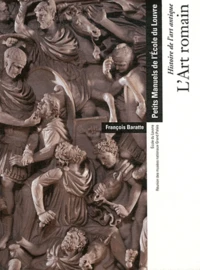- Accueil /
- François Baratte
François Baratte

Dernière sortie
Polychroma
Long ignored, sometimes knowingly, since the idea of its presence went against the ideals of a white and pure ancient sculpture propagated post Winckelmann, the polychromy of classical and late sculpture and architecture has been the subject of important research programmes for thirty years. Within this field of study, the book focuses on the peculiarity of Roman imperial polychromy and its late developments (first century BC - sixth century AD) to investigate the technical features and the socio-cultural meaning of colours.
After an assessment of the studies on polychromy already carried out, this book presents the first results of the EU-MSCA-IF PolyCHRoMA project, which documented traces of colours not immediately visible (lost colours) through the physico-chemical analysis of a new corpus of sculptural and architectural elements from some major European and North African museums (Musées royaux d'Art et d'Histoire de Bruxelles, Musée royal de Mariemont, Musée départemental Arles antique, Musée Saint-Raymond de Toulouse, Museo Archeologico di Milano, Museo Nazionale e Museo Arcivescovile in Ravenna, Bardo National Museum and others Tunisian collections).
The systematic chronological and contextual study of these traces, before time ensures the loss of colours, confirms that polychromy offers a new source for assessing the cultural meaning of colour at the turn of the first millennium.
After an assessment of the studies on polychromy already carried out, this book presents the first results of the EU-MSCA-IF PolyCHRoMA project, which documented traces of colours not immediately visible (lost colours) through the physico-chemical analysis of a new corpus of sculptural and architectural elements from some major European and North African museums (Musées royaux d'Art et d'Histoire de Bruxelles, Musée royal de Mariemont, Musée départemental Arles antique, Musée Saint-Raymond de Toulouse, Museo Archeologico di Milano, Museo Nazionale e Museo Arcivescovile in Ravenna, Bardo National Museum and others Tunisian collections).
The systematic chronological and contextual study of these traces, before time ensures the loss of colours, confirms that polychromy offers a new source for assessing the cultural meaning of colour at the turn of the first millennium.
Long ignored, sometimes knowingly, since the idea of its presence went against the ideals of a white and pure ancient sculpture propagated post Winckelmann, the polychromy of classical and late sculpture and architecture has been the subject of important research programmes for thirty years. Within this field of study, the book focuses on the peculiarity of Roman imperial polychromy and its late developments (first century BC - sixth century AD) to investigate the technical features and the socio-cultural meaning of colours.
After an assessment of the studies on polychromy already carried out, this book presents the first results of the EU-MSCA-IF PolyCHRoMA project, which documented traces of colours not immediately visible (lost colours) through the physico-chemical analysis of a new corpus of sculptural and architectural elements from some major European and North African museums (Musées royaux d'Art et d'Histoire de Bruxelles, Musée royal de Mariemont, Musée départemental Arles antique, Musée Saint-Raymond de Toulouse, Museo Archeologico di Milano, Museo Nazionale e Museo Arcivescovile in Ravenna, Bardo National Museum and others Tunisian collections).
The systematic chronological and contextual study of these traces, before time ensures the loss of colours, confirms that polychromy offers a new source for assessing the cultural meaning of colour at the turn of the first millennium.
After an assessment of the studies on polychromy already carried out, this book presents the first results of the EU-MSCA-IF PolyCHRoMA project, which documented traces of colours not immediately visible (lost colours) through the physico-chemical analysis of a new corpus of sculptural and architectural elements from some major European and North African museums (Musées royaux d'Art et d'Histoire de Bruxelles, Musée royal de Mariemont, Musée départemental Arles antique, Musée Saint-Raymond de Toulouse, Museo Archeologico di Milano, Museo Nazionale e Museo Arcivescovile in Ravenna, Bardo National Museum and others Tunisian collections).
The systematic chronological and contextual study of these traces, before time ensures the loss of colours, confirms that polychromy offers a new source for assessing the cultural meaning of colour at the turn of the first millennium.
Les livres de François Baratte

La revue des musées de France. Revue du Louvre N° 1, Février 2012
Revue des musées de France 2012 n1
Marie-Christine Labourdette, François Baratte, Geneviève Bresc-Bautier, Christian Briend
15,00 €

Recherches archéologiques à Haïdra. Volume 4, La basilique II dite de Candidus ou des martyrs de la persécution de Dioclétien
François Baratte, Fathi Bejaoui, Noël Duval, Jean-Claude Golvin
110,00 €

10,00 €

Basiliques chrétiennes d'Afrique du Nord. Tome 2, Inventaire des monuments de la Tunisie
François Baratte, Fathi Bejaoui
Beau Livre
60,00 €
Iconographie funéraire romaine et société : corpus antique, approches nouvelles ?
Martin Galinier, François Baratte
28,00 €

Fouilles d'Apamée de Syrie. Tome 5, Les maisons du cerf et ses mosaïques. La maison des chapiteaux à consoles
Janine Balty, François Baratte, Guy Donnay, Claudine Donnay-Rocmans
Grand Format
73,90 €

28,00 €

Des Domus Ecclesiae aux palais épiscopaux. Actes du colloque tenu à Autun du 26 au 28 novembre 2009
Sylvain Balcon-Berry, François Baratte, Jean-Pierre Caillet, Dany Sandron
Grand Format
84,90 €

Autour du trésor de Mâcon. Luxe et quotidien en Gaule romaine
François Baratte, Martine Joly, Jean-Claude Béal
15,00 €

20,00 €
